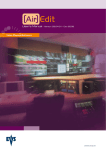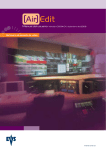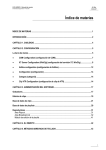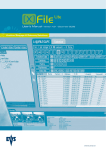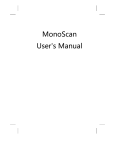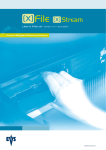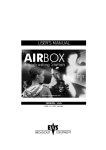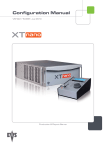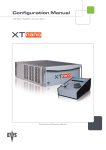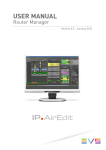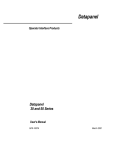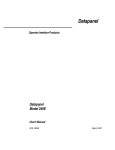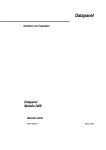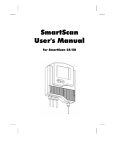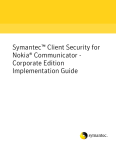Download AirBox 03.04.09 User Manual
Transcript
User's Manual - Version 03.04.07 - May 2007 Video Playout Software www.evs.tv EVS AIRBOX - User’s Manual EVS Broadcast Equipment SA – May 2007 Air Box 03.04.07 Table of contents TABLE OF CONTENTS .......................................................................................................................... 1 INTRODUCTION...................................................................................................................................... 2 CHAPTER 1 - CABLING ......................................................................................................................... 4 CHAPTER 2 – CONFIGURATION........................................................................................................... 5 The Menu Bar ......................................................................................................................................... 5 • COM configuration.................................................................................................................... 7 • XT Server Configuration (WinCfg)........................................................................................... 8 • AirBox configuration .............................................................................................................. 12 • Configuration .......................................................................................................................... 14 • Category .................................................................................................................................. 14 • Clip VTR Configuration........................................................................................................... 14 CHAPTER 3 – SOFTWARE MANAGEMENT ....................................................................................... 16 The Recorders...................................................................................................................................... 16 The Clip Edition.................................................................................................................................... 19 The Clips Database .............................................................................................................................. 21 The Playlist Database .......................................................................................................................... 28 The Players........................................................................................................................................... 29 Playout Area ...................................................................................................................................... 30 The Broadcast List Area .................................................................................................................... 31 The Edit Module of the Playlist .......................................................................................................... 40 CHAPTER 4 – REMOTE CONTROL PANEL........................................................................................ 41 CHAPTER 5 – KEYBOARD SHORT CUTS .......................................................................................... 42 1 EVS AIRBOX - User’s Manual Air Box 03.04.07 EVS Broadcast Equipment SA – May 2007 Introduction The Air Box is a small-scale, cost-effective playout system that controls up to 6 fully independent channels, freely configurable of an EVS XT Series server (SD and/or HD). The AirBox-XT is an efficient non-linear editor with an intuitive Windows® user interface: Any clip, local or remote, can be incorporated in playlists with straightforward “drag & drop” commands. User programmable filters help to retrieve that one particular shot swiftly, which can then be previewed at once without ever disturbing the operator who captured it. The integrated playlist automation makes the AirBox-XT a very cost effective solution for non-stop, unattended broadcast operations. Sequences are played with transition effects reliably, timed either by a clock or triggered by a GPI. Main operational features Independent Rec & Play channels No need to wait until action is completed. It is also possible to play back material while it is still being recorded (time shift delay). Clip management The XT Series Server attached to the Air Box can store up to 2048 (HCTS 1 s t generation) or 4096 local clips (HCTS 2 n d generation or HCTX). For a successful database organization, each clip has a unique 8-character ID, a name (24 characters), a description (type & category), a priority rating and up to 3 different keywords. Playlist management Non-linear editing facilities such as Insert, Remove, Loop function, freeze frame, etc… allow the operator to build the playlist. The playlist can be modified while it is on air. A second playback channel can also be used to preview automatically the first frame of the next clip due to be on air in the playlist. External VTR control (Sony BVW75 protocol) - To ingest some content onto the server - To chain material from the VTR (longer duration) with other material recorded on disk (short or medium duration) with frame accuracy. 2 EVS AIRBOX - User’s Manual EVS Broadcast Equipment SA – May 2007 Air Box 03.04.07 User-friendly interface Dedicated remote panels, mouse, keyboard & SVGA monitor allow a full control of the Air Box. 3 EVS AIRBOX - User’s Manual Air Box 03.04.07 EVS Broadcast Equipment SA – May 2007 Chapter 1 - Cabling The AirBox software is installed in a workstation operating under Windows NT 4.0 system. The communication between the XT Series Server and the Air Box application is done through an RS422 connection using EVS Advanced Video Server Protocol (XT Series Server AVSP*). For the cabling of the XT Series Server itself, please refer to the XT Technical Reference. It is possible to combine the Air Box with the well-known Multicam Remote and with the new IP Director application. *Check your XT version for a proper configuration 4 EVS AIRBOX - User’s Manual Air Box 03.04.07 EVS Broadcast Equipment SA – May 2007 Chapter 2 – Configuration The complete control of the Airbox is organized into one single screen for recording the material, for creating and editing clips, for forming the playlists and for sending the Playlist screenplay On Air. Double-click on the Airbox Icon to begin: The Menu Bar The familiar Windows-NT Menus are located in the Menu Bar: The File menu gives you access to a main function: • Load EDL: this item is only used for integration of EVS systems. EDL file format currently supported is EVS EDL. • Database: this option allows you to open, export, import or clear a database. “Info” gives you some information about the database loaded and “Execute Script” Will let you load a database with different options. These functions should be only used by trained EVS engineers for maintenance operations. 5 EVS AIRBOX - User’s Manual Air Box 03.04.07 EVS Broadcast Equipment SA – May 2007 The View menu allows you to configure your screen display as desired. • Status Bar: this item displays or hides the Status Bar and the Capacity left counter. • Playlist List: this item displays or hides the first column in the player area. • Recoder/Recorder & Player/Player: this item offers 3 modes of display for your AirBox interface: Player mode only displays the Players, Recorder mode displays all recorders, and Recorder & Player mode displays both recorders and players. S h or t c ut s a r e a v a i l a b le t o q u i c k l y m o d i f y th e d i s p l a y o f p l a y er s , r e c or d er s a nd D at a b a se : • SHIFT+F5: only displays th e r e c or d ers w i n do w s an d t o g g le s be twe e n r e cor d ers . • S H IFT + F 6 : d i s p l a y s bot h r e c or d ers a n d p l a ye r s w i n do w s. • SH IFT +F7 : on ly d isp la ys t h e p la yer ’s w ind ow s an d t o g g le s be twe e n p l a y er s . • S H IFT + F 8 : d is p l a y s / h id e s t h e D at a ba s e ar e a . • Database: this item displays or hides the Clip/Playlists database area. • OSD: this item offers you 4 options to see Genlock error message on the OSD (!GKV), to use the default layout for the OSD (time code, in and out, clip name), or to view/hide time code and time left (in a playlist) 6 EVS AIRBOX - User’s Manual Air Box 03.04.07 EVS Broadcast Equipment SA – May 2007 • Hide PlayOut : this item displays or hides the PlayOut • Message List: this item displays internal messages from the AirBox running status (message.txt file).The frequency of the messages can be selected from level 0 (all internal debug messages) to level 2 (error messages only). The Tools menu opens different dialog boxes with which your entire system is configured: • COM configuration The COM configuration dialog box allows you to assign the serial communication ports available on the AirBox to the peripheral equipment: The XT Series Server, the remote control panels and the different VTR machines. The Baud rate selection box allows you to define the transfer rate between the AirBox and the XT Series Server. Default is 115200. “Small Remote” checkboxes select the type of remote control panel to be used. 7 EVS AIRBOX - User’s Manual Air Box 03.04.07 EVS Broadcast Equipment SA – May 2007 This box should be checked if using the type of remote as described in chapter 4 (Remote Panel Description). This box should be left unchecked when using the Remote D (larger remote with jog and tbar). Comment: Serial ports configuration has been tested to efficiently carry out its functions. Please do not modify the standard configuration. If you need to do so, just drag the com name into a particular control box. • XT Server Configuration (WinCfg) The WinCfg dialog box allows you to set up the configuration of the XT Series Server from the AirBox. These parameters are also available from the EVS and AVCFG applications directly on the XT Series Server system monitor. For a more detailed description of these parameters, please refer to the “EVS Advanced Parameters” and “AVCF G” sections of the Technical Reference for XT Series Server. RS422 Ports: To configure the COM ports of the XT Series Server. RS422 Port #1 must be assigned to the EVS AVSP protocol to work with the AirBox. When in the stand alone mode, the AirBox PC must be connected to the RS422 port #1 of the XT Series Server. 8 EVS AIRBOX - User’s Manual EVS Broadcast Equipment SA – May 2007 Air Box 03.04.07 Video Channels: to configure the sharing of disk capacity between the record channels. Click on the “Change” button in the upper part of the window to change the number of rec and play channels. Channels Configuration (“Change” button): Click on the “Change” button to call the list of available configurations for your Air Box and XT Series Server. Depending on the number of video channels available on the XT Series Server controlled by the Air Box, different windows can appear: For example, for a 6-channel XT Series Server: Transition effects (Dissolve, Wipes) require 2 video channels linked to form one “Play Mix” channel. Note that MultiAudio mode (2 stereo audio tracks per video channel) is not available in this version 02.00.50. 9 EVS AIRBOX - User’s Manual EVS Broadcast Equipment SA – May 2007 Air Box 03.04.07 Audio Outputs : Displays the current assignment of audio output channels of the XT Series Server. Audio Inputs : Displays the current assignment of the audio input channels of the XT Series Server. 10 EVS AIRBOX - User’s Manual EVS Broadcast Equipment SA – May 2007 Air Box 03.04.07 SDTI Network : To define the parameters of the XNet SDTI Network. Advanced Parameters : to configure the Guardband (duration of material beyond the IN and OUT point that will be automatically protected when creating a clip) and other video format and hardware configuration parameters. It is advisable to Save the configuration when switching the number of channels specially because of the audio monitoring. 11 EVS AIRBOX - User’s Manual Air Box 03.04.07 EVS Broadcast Equipment SA – May 2007 • AirBox configuration The AirBox configuration item opens the following dialog box and allows you to define default settings for your AirBox application: The In Effect Duration Default field defines the default duration of effects (Dissolve or Wipe) into a playlist. The Transition Duration Default field defines the default duration of an effect defined in Start Mode. These parameters can be modified for each clip after it has been inserted in the playlist. Show “Parameters Clip Edition” Dialog option displays/hides the parameters dialog box appearing after each clip creation. Note that this window never appears when the “Clip Create Simultaneously” is active (this option is described a few lines below). Show Edition player at start-up displays/hides. The editing channel only remains active for clip edition. 12 EVS AIRBOX - User’s Manual EVS Broadcast Equipment SA – May 2007 Air Box 03.04.07 Clip Create Simultaneously: when this option is enabled, clips will automatically be created simultan eously on all record channels. When this option is disabled, the clip is created on the selected record channel only. Default In Point hh:mm:ss:fr enables or disables a default time code value for the in point for all clips when they are created. Play on double click allows you to start the playback of the playlist by double clicking on a clip in the playlist window. The playlist will start from that clip. If this option is disabled, the clip will be preloaded but the playback does not start automatically. Double-click disabled in Play mode: when this option is checked, double clicking on a clip inside a playlist when the playlist is playin g will not stop the playlist to load the selected clip. OSD Playlist when this option is checked, the name of the previous, current and the next 2 clips of the playlist will appear on the OSD. Delete Clip On Database Event : when this option is checked, it automatically removes a clip from the AirEdit database when it is deleted from the server by another user. If this option is not checked, then a popup window appears to ask the operator whether or not he wants to keep this clip in the database even though it is not longer available on the XT Series Server. Delete Clip from Database Default : if “Delete Clip On Database Event” is not selected, when a clip is deleted from the server by another user, a popup window appears to ask the operator whether or not he wants to keep this clip in the AirEdit database. If the “Delete Clip from Database Default” is checked, the the default choice in this window is to delete it from the database. If this option is not checked, the default choice in this window is to keep it in the database. Fast Jog option allows you to set the speed of the Fast Jog function on the remote panel. Insert new clip in fist position : if this option is selected, a new clip will be inserted in top position in the clip database. If this option is not selected, the position of a new clip in the clip database will be defined by the current sorting criteria. Autoedit select ID window : if this option is selected, when creating a clip with VTR control, a popup window appears to allow the operator to define a name for the clip to be created. If this option is not selected, no popup window appears and the clip name is automatically generated. GPI Cmd In triggered on \ : when this option is checked, the NEXT command linked to the reception of a GPI signal by the AirBox will actually be performed when the GPI level goes from high to low. If it is not checked, the NEXT command will be performed when the GPI signal changes from low to high. 13 EVS AIRBOX - User’s Manual Air Box 03.04.07 EVS Broadcast Equipment SA – May 2007 • Configuration Not used in AirBox mode • Category This item gives you access to the Media and Type management. These two key parameters are useful to organize, sort and find clips in the database. • Clip VTR Configuration The Clip VTR option allows you to play back a video clip from a VTR and insert it inside a playlist. That way you can combine clips from the XT Series Server and clips from tape inside the playlist. Selecting the Clip VTR Configuration item opens the following dialog box: Default Preroll Time: The Preroll command is sent to the VTR via the RS422 connection. Default: 10 seconds Time to cue VTR: minimal duration to cue the VTR. Default 25 14 EVS AIRBOX - User’s Manual Air Box 03.04.07 EVS Broadcast Equipment SA – May 2007 seconds Delay to Play: defines the delay between the input and output channels of the server for a “Clip VTR”. Default: 5 seconds Control VTR Default Values: If this option is selected, the values for In, Out and Duration are used as default value to populate the corresponding fields in the VTR control window. • Redundancy This function is not yet available. • Set Date This item allows you to set date of the Air Box application at start up. The On Air Time is always displayed with the date in the Menu bar in the top right corner of the VGA: • Clear TC Table This item allows emptying the TC table files when it is full. In that case, the message TC! is showed on the OSD. This problem happens when the Time Code source is not referenced to the same signal used for the Video Server reference (Black Burst). The Help menu opens the software information window. This window provides information about the software version of the Air Box application and about the compatibility with the version of the Multicam software that must be installed on the XT Series Server. 15 EVS AIRBOX - User’s Manual Air Box 03.04.07 EVS Broadcast Equipment SA – May 2007 Chapter 3 – Software management The Recorders The recorder is represented by a Record button and the Record time, the duration already recorded and a lock/unlock record button. To start and to stop the record, press the Record button. If no TimeCode reference is entered to the XT Series Server, then the internal PC clock of the XT Series Server is used as a reference. Select the corresponding tab to view the desired record channel. Selecting ‘All’ displays all recorders. The VTR control panel and Record er List are accessible from each recorder tab. The standard functions needed to control a VTR are available here: Play, Stop, Still (pause), Rewind and Fast Forward, Preroll and its duration. The scrolling bar allows you to search the tape in Jog mode or in Shuttle mode. The current status of the VTR is continually sent back to the AirBox for better control. The status field indicates what the VTR is doing with a tape sequence (Idle, Playing, Rewinding…). Important note: the TC of the VTR is sent to the Air Box through the RS422 connection between the VTR and the Air Box PC. Do NOT connect the LTC output of the VTR to the LTC input of the XT Series Server. The LTC input of the XT Series Server must only be used to lock the server to the station’s timecode reference. Right click on the “Control VTR” tab to select the VTR you want to control. 16 EVS AIRBOX - User’s Manual EVS Broadcast Equipment SA – May 2007 Air Box 03.04.07 When IN and OUT points are defined, the Auto Edit button starts the playback of the VTR (from the IN point to the OUT point, taking into account the preroll duration) and the record of the XT Series Server at the same time. The Clip VT R option allows you to blend sequences from disks and sequences from tapes into a same playlist. It creates a virtual clip (entry) into the database. This new Clip VTR has the same parameters (ID, Name, Type, Duration…) as clips coming from the disks and can be easily found in the database, and can be inserted in any playlists. The Recorder List module is an automatic hands-free recorder. Sequences of recordings can be scheduled in advance. To create a new event (clip), press the New button. The following dialog box appears to enter the parameters: 17 EVS AIRBOX - User’s Manual EVS Broadcast Equipment SA – May 2007 Air Box 03.04.07 Parameters as Name, ID, Media, and Type are standard parameters to identify the new clip into the clips database. Start Date, Start Time and duration are mandatory parameters to schedule a record sequence. 18 EVS AIRBOX - User’s Manual Air Box 03.04.07 EVS Broadcast Equipment SA – May 2007 Periodicity/AutoDelete This function allows to record a live show every day and to rebroadcast it using the periodicity/autodelete parameters. For example: The Weather Forecast recorded every day at a fixedhour is re-broadcasted several times during the following hours. The day after, the new Weather Forecast is recorded and the old one is deleted, and so forth. The Periodicity parameter defines the time (days, hours, minutes, seconds, frames) of the next recording. The AutoDelete parameter defines the time to automatically delete an old clip. Note that the AutoDelete of the “old” clip must be completed at least 3 seconds before the “new” clip is created according to the Periodicity parameters, otherwise an error message will warn the user. The Clip Edition The clip edition module is used to browse the recorded material and to create clips from this material. The Current TimeCode field allows you to enter a defined TimeCode Reference and go to this TimeCode reference: Enter a new TimeCode position in the TimeCode field and press Enter to validate. The IN, OUT and Duration fields are also editable and allows to enter a defined IN, OUT point or a defined duration. Creating a clip Press the corresponding LIVE button (1, 2, 3 or 4) to visualize the desired record channel. Browse to the desired IN/OUT points, press the IN/OUT button to mark the first/last frame of the clip; this can be done “on the fly” or by accurately positioning the material with the scrolling bar (or with 19 EVS AIRBOX - User’s Manual Air Box 03.04.07 EVS Broadcast Equipment SA – May 2007 the jog knob of remote). To clear an IN/OUT point, press the CLEAR IN/CLEAR OUT button. When the IN and OUT points of the clip have been marked, press the Save Clip button to display the Clip Edition dialog box. Important Note: The number of characters for the clip name must not exceed 24 characters. In order to comply with the XT Series Server operating system, ID name (up to 8 characters) has been automatically linked to the Clip Name at the time of the creation of this one. Media, type, creation date, clip category, or various comments can be added to the clip for information. We can also add some default keywords previously imported into the server. Each file (.kwd) contains up to 200 keywords and we can assign a maximum of 3 keywords for each clip. The Rating is so to set a priority level to a clip (from 0 to 3 stars). If we want a particular clip to go to a specific location (folder), we can also do so by choosing the name of that folder in this window (i.e: NAT for national). Bin rules are also available so that the clips made from one feed will go to the desire folder. Press the SAVE button to enter the new clip into the Clips Database. Media and type can be modified in the menu Tools/Category. In the Master Configuration menu, it is possible to disable the automatic display of the Clip Edition dialog box. In this case, the clip is immediately save when clicking the SAVE button. 20 EVS AIRBOX - User’s Manual Air Box 03.04.07 EVS Broadcast Equipment SA – May 2007 The Clips Database The list of existing clips appears at the bottom of the screen in the database area with the information/attributes assigned to each clip. The attributes and clips are not permanent and can be modified. Clicking on the title of a column re-organizes the list display (for example: clicking on Clip Name title or on one of the Keywords will sorts the whole list in alphabetical order, clicking on the In title sort the clips according to the timecode of their IN point). The Status column displays the current status for each clip: green sign means that the clip is present on the XT Series Server and into the clips database on the Air Box PC. A red sign means that data or a clip on the XT Series Server is missing for playback. The operator can hide, show and re-order selected columns. Rightclick into the title bar of the database to open the List ordering window: A drag and drop facility allows you to move the fields and to reorder them as desired. Double-click on a field to hide/show the corresponding column in the database. A column is hidden when its name is grey in the List Ordering window. 21 EVS AIRBOX - User’s Manual Air Box 03.04.07 EVS Broadcast Equipment SA – May 2007 Inside the clip database area, right-clicking on a clip will call the option pop-up menu: The Change clip ID item allows changing the ID of the current clip. The Change TimeCode item allows to re-define the timecode of the IN point of a clip. The timecode of the entire clip will be recalculated accordingly, so that it remains continuous. The Lock/UnLock item locks/unlocks the selected clip. This means that this clip can no be removed from the Database and modifications (name, IN and OUT points…) are not authorized. A padlock symbol is displayed in the status field. The Delete item deletes the selected clip(s) from the database. The Search function allows you to search for a clip in all databases The Check DataBase item checks the validity of the database contents (Sequence-fields in the.mdb file). In order to check the validity of the video sources, the Check DataBase function compares the clips recorded on the disks of the XT Series Server and the clips listed in the database of the Air Box PC. The two lists must be identical to be valid. It is recommended to proceed with this checking process on a regular basis to identify/remove unavailable clips from the database. Indeed, when deleting clips from the server, the operator can select to keep the reference to these clips inside the database. 22 EVS AIRBOX - User’s Manual Air Box 03.04.07 EVS Broadcast Equipment SA – May 2007 When selecting this option, the following window appears: The following buttons are available at the bottom of the window: • • • • • • Check all: check all servers present on the SDTI network. Check required: check only the required servers. When a new server appears on the network, a database check must be performed before using its clips. Check Local: check only the local server. The local server is the one directly connected to the Air Box PC through the RS422 connection. Clear Unavailable: allows the operator to clear the clips marked ‘unavailable’ Stop: stop the database check process. Exit: exit the database check window Important note: The facilities for network functions (i.e. copying or moving a clip from one XT Series server to another) are not yet available in version 3.04.07. However it is possible to make a local copy of a network clip by loading the network clip and saving it again as a local clip. 23 EVS AIRBOX - User’s Manual EVS Broadcast Equipment SA – May 2007 Air Box 03.04.07 The Archive item sets the archiving status for the selected clip(s) to export them to an EVS XFile or XStore system. The Rating items is used to change the rating of the selected clip(s). Rating can be – (none) or 1, 2 or 3 stars. The Edit item opens the clip parameters dialog box for modification. The Copy item copies the selected clip(s) to the clipboard in order to paste it (them) later in a playlist. Several clips can be selected by holding the SHIFT key when clicking. 24 EVS AIRBOX - User’s Manual Air Box 03.04.07 EVS Broadcast Equipment SA – May 2007 Filters In the clips database, filters are available to refine the selection. It is possible to associate a clip to various filters, and then use these filters to sort the database and quickly locate the desired clips. To view the entire database without applying any filter, click on the Rst Flt button (“Reset Filters”) To associate a clip to a filter, drag&drop this clip to the desired filter button. The clip is not duplicated, it is only associated to the corresponding filter inside the database. So you can create filters for Sports, Jingles, and Ads … Each filter button can be renamed: right-click on the filter button to rename, and select the Rename op tion. A dialog box appears where the new name of the filter can be typed. To view only the clips associated to a filter, click on the corresponding filter button. The AND checkbox: If the AND checkbox is unchecked, the database area displays the sum of all clips contained in each of the filters currently applied. Example: If Clip0001 is associated to filter 1, it will be displayed when viewing the database even when filter 1 and filter 2 are applied simultaneously. While the AND box is checked, the database field displays a crossselection of clips contained in the selected filters. (i.e. clips present in filter 1 AND filter 2). Example: If Clip0002 is associated to filter 1 and filter 2, it will be displayed when viewing the database with filter 1 and filter 2 applied. If Clip0002 is associated to filter 1 but not to filter 2, it will not be displayed. 25 EVS AIRBOX - User’s Manual Air Box 03.04.07 EVS Broadcast Equipment SA – May 2007 Keywords To import the keywords into the system, we first need to create a document with the .kwd extension that will look like the example shown below. 1=R.Madrid 2=Luxemburgo 3=Raul 4=Zidanne ….. Leave empty spaces to organize the grid. We then save the file into a disk or a USB memory pen that later we will insert into the XT. Before running the Multicam, we go to the Advanced Parameters (F9) in the EVS Maintenance Menu and choosing the option: import/export keywords. 26 EVS AIRBOX - User’s Manual Air Box 03.04.07 EVS Broadcast Equipment SA – May 2007 Video server window: Application Window Title Bar Configuration Window Message Window Task Bar Start the application and then press SHIFT + F2 to open the following window: Then select the keyword file to use from the clip management area. For more information regarding the settings of the video server, please refer to Technical reference manual. 27 EVS AIRBOX - User’s Manual Air Box 03.04.07 EVS Broadcast Equipment SA – May 2007 Database Filter Using the Database Filter allows us to search media by their position on the XTs and, their camera angle, the different keywords already associated to the clips, the rating, TC, or even by a date interval in one or more Servers of the XNet. The Playlist Database Note: The playlist duration is displayed when its duration (clips duration + transition effects) can be calculated. If one parameter (GPI, Break, Loop…) makes the exact calculation impossible, the playlist duration is nil. The attributes of playlists can be re-organized. The operator can hide, show and re-order selected columns. Right-click in the title bar of the database to order the columns. 28 EVS AIRBOX - User’s Manual Air Box 03.04.07 EVS Broadcast Equipment SA – May 2007 This window works similarly to the List ordering window for Clips, already described in this manual. In the Playlist Database area, righ-click on a playlist to call the playlist contextual menu. The New item opens a new playlist 01 in a player module. If no channel is available, the system will warn the user. The Duplicate item copies the selected playlist with the automatic naming: playlist_name-copy. A dialog box opens to change the playlist name. The Delete item removes the selected playlist(s) from the database. Multiple selections can be performed by holding the Shift key while clicking. The Rename item renames the selected playlist. The Refresh item forces the playlist database to be refreshed. The Players PLAY MIX: player channel with transition effects (cut, mix or wipe). This “dual” channel requires 2 video player channels. Only one PLAY MIX channel is available per configuration. 29 EVS AIRBOX - User’s Manual Air Box 03.04.07 EVS Broadcast Equipment SA – May 2007 PLAY CUT 1, 2, 3, 4: up to 4 player channels available. The PLAY CUT channel plays back a playlist with only cut effects between clips (no mix or wipe). Each player is divided into 3 modules: the Playout area, the Broadcast List area, and the Edition module. Playout Area This area displays the clip On Air and the next clip loaded. The PLAY, GOTO IN, GOTO OUT, LOCK, STOP, PAUSE, NEXT, SKIP buttons affect the loaded playlist. The PLAY button starts the playback of the clip currently preloaded on the play channel. The GOTO IN / GOTO OUT buttons allow jumping directly to the IN / OUT point of the current clip. Useful tip: when previewing the playlist, you can recue to the IN point of the clip currently playing by clicking on the GOTO IN button. The LOCK button disables the controls over the current playlist to secure the playback and avoid that an accidental click disturbs the playlist while on air, for example. The STOP button stops the playli st and set the channel in idle mode. The PAUSE button freezes the play of the playlist on the current picture. The NEXT button allows you to force immediately the transition to the next item in the playlist The SKIP button allows you to skip the next clip due to playback. For example, if you click on the SKIP button while playing the 3 r d clip of a playlist, the next clip to play will be the 5 t h one instead of the 4 t h one. To load a playlist to the playout area, • Either select the desired playlist and drag&drop the playlist into the diffusion field • Or double-click on the playlist/clip you want to load in the diffusion area. 30 EVS AIRBOX - User’s Manual Air Box 03.04.07 EVS Broadcast Equipment SA – May 2007 The Broadcast List Area The name of current playlist is displayed in the first field in the top left corner of this area. Creating a playlist Right-click in the Playlist Name field and select the New Playlist option from the pop-up menu: Or drag & drop a clip from the clips database to the clip field: a new playlist is automatically created. (To proceed as described, the playlist field must be empty, use the Clear Broadcast List item to remove the playlist from this area.) Add other clips with drag&drop facility or use the copy/paste functions. The SAVE option saves the new playlist into the playlist database. Note that a playlist is not saved until this function has been called. 31 EVS AIRBOX - User’s Manual Air Box 03.04.07 EVS Broadcast Equipment SA – May 2007 In the broadcast list, type of effect, duration of the effect, start mode and on air time can be defined. Right-clicking on a clip in the broadcast list will display the following pop-up menu to give you access to different options: CUT: remove the selected clip(s) from the broadcast list and store it in the clipboard of the application. COPY: store the selected clip(s) in the clipboard of the application. PASTE: insert the clip(s) previously stored in the clipboard of the application in the broadcast list at the current position. DELETE: remove the selected clip(s) from the broadcast list. Insert / Modify Loop The INSERT/MODIFY item inserts a LOOP into the playlist. 32 EVS AIRBOX - User’s Manual Air Box 03.04.07 EVS Broadcast Equipment SA – May 2007 With counter: Enter the number of times the section of the playlist inside the loop will playback before exiting the loop and continuing the rest of the playlist. With Time condition: the number of loop is unknown but the deadline is known. Enter the Time and/or the date. When this time and date is reached while playing, the playlist will automatically exit the loop and continue the playback of the rest of the playlist. Without Time condition: The playlist will loop indefinitely until manually stopped or forced to chain to the next clip after the loop inside the playlist. Press ENTER to validate the selection. In the broadcast list area two LOOP lines (Start and End of the loop) appear. Drag & drop the Start Loop/End Loop lines to the desired positions. A playlist can include more than one loop but a loop sequence can not be included into another loop sequence. Insert / Modify Live “Live” sequence can be included in the playlist, but there is a minimum delay of 3 seconds between the pictures recorded at the input of the XT Series Server, and the moment the server is able to playback this picture. This delay can be increased by the operator if required. When inserting a “Live Clip” inside a playlist, the following parameters must be defined: IN point: Train: select the record channel on which the live feed is being recorded Delay: define the delay to apply between the record and the playback of the “live clip” TC In: instead of a delay, the operator can specify the time code of the picture to use as the IN point of the “live clip”. 33 EVS AIRBOX - User’s Manual Air Box 03.04.07 EVS Broadcast Equipment SA – May 2007 OUT point: None: no OUT point is specified. The “live clip” will play until the operator or a JUMP start mode force the transition to the next item in the playlist. Duration: the “live clip” will play for the specified duration TC Out: the “live clip” will play to the picture corresponding to the TC Out defined by the operator Start Mode The parameters linked to the Start Mode are similar to those explained in the specific Start Mode paragraph. IN Effect The IN EFFECT item opens a dial og box in order to define a start effect to the current clip. Three different effects are available: CUT, MIX, and WIPE. The Wipe effects available with your system are represented by the following icons: When selecting a Mix or Wipe effect, the Air Box automatically proposes the duration defined as the default duration for Mix and Wipe effects in the configuration window (Tools Menu), but the duration of the effect can be modified for each clip. The operator can also assign as new default settings the effect type and duration currently displayed in the IN Effect window by clicking on the DEFAULT…” button. 34 EVS AIRBOX - User’s Manual Air Box 03.04.07 EVS Broadcast Equipment SA – May 2007 GPI controls The GPI out allow you to send GPI commands to peripheral equipment (Logo inserter, Switcher…). Up to 4 GPI commands are available per clip. The TC IN and OUT for the selected clip is displayed in this window. Select the GPI associated to your peripheral equipment and the GPI level (high, high pulse, low, low pulse) and then select the TimeCode reference at which the GPI command must be sent. Set Speed The set speed item allows you to set speed of a clip (from 1 % to 300 %) Start Mode Inside a playlist, clips can be chained automatically (the next clip starts when the current clip ends), but it is also possible to freeze on the last or first field of a clip and wait for a particular action or time before resuming the playback. The available STILL MODES are: None: the next clip starts automatically when the current one ends. In this mode, the START TYPE area of the window is not available. 35 EVS AIRBOX - User’s Manual EVS Broadcast Equipment SA – May 2007 Air Box 03.04.07 Jump: force the play back of a clip at a defined time even if a loop or another clip is playing. This option is useful to go out of a loop program or for playing back clock jingles at fixed-hour, for example. Still first frame of the current clip: when the on-air clip ends, the Air Box will pause on the first frame on the next one Still last frame of the previous clip: when the on-air clip ends, the Air Box will pause on the last frame of that clip Still from last to first (with a defined duration): when the on-air clip ends, the Air Box will pause on the last frame of that clip for the set duration, then will chain to the first frame of the next clip and pause. The START TYPE allows you to define how a clip should be started inside the playlist: Manual: the operator has to click on the play button or press the play key on the remote to start the playback of the clip On Time (with time and date): the clip will automatically start at the set time and date. Note that the reference for this command is the time code input of the XT Series Server. GPI: the clip will start when the corresponding GPI is received by the XT Series Server. The DEFAULT button saves the new parameters as default. Every time a clip is inserted inside a playlist, these default values will be used to define the Still Mode and Start Type of the transition between the new clip and the previous one. After the playlist creation, save the current playlist (right click on the Playlist Name field and select the SAVE option) to enter the new playlist in the Playlist database. 36 EVS AIRBOX - User’s Manual Air Box 03.04.07 EVS Broadcast Equipment SA – May 2007 Note: Changing time in ‘Jump’ mode is not allowed while a playlist is loaded or in play mode. Print The print option allows you to print the selected playlist. Set On-Air Time The Set On-Air Time option allows you to set an On-Air time and date for the current playlist, in order to simulate the schedule of the playlist as if started at this date and time. Note that this parameter is only used to simulate the schedule while building the playlist, but is not used to actually trigger the playback of the playlist. Goto Timecode The Goto Time code option allows you to jump to the corresponding time code inside the current element of the playlist. Player Options A right click on the player name (ie:Cut(03)) and the following popup appears: Rename: This item allows renaming the Player. This name is also showed on the OSD. Properties: This item allows selecting the remote dedicated to the current player. Next On GPI: This item allows to enable the GPI on the Next function. The following popup appears: Select which GPI you want to affect on this player for the Next function. Only one GPI can be used per play channel. The GPI must be configured before in the MULTICAM Setup-up menu. 37 EVS AIRBOX - User’s Manual EVS Broadcast Equipment SA – May 2007 Air Box 03.04.07 To Mix/to cut: This option allows to configuring the player as a Player Mix or a Player Cut. In Mix mode, 2 players are required. IMPORTANT: You must stop all the players to swap between the 2 modes. Freeze On Field / Freeze On Frame : defines the video freeze mode. When “Freeze On Field” is selected, only 1 field is displayed when the player channel is in pause mode (clip preload, manual pause, start mode). When “Freeze On Frame” is selected, both fields are displayed when the player channel is in pause mode, resulting in a better resolution for still graphics. When a player channel is set in “Freeze On Frame” mode, a (F) appears next to its name in the tab. Left click on the” Freeze On Field” or “Freeze on Frame” option to switch from one mode to the other. IMPORTANT: when several players are synchronized together, they must all use the same freeze mode. The freeze mode must be set individually for each channel. Sync: This item allows synchronizing 2 or more channels together. The following popup appears: Select the play channel that you want to synchronize, right click on the name of that channel inside the corresponding tab, select the “Sync To” option, then select which channel will be the “master” channel to synchronize to. Repeat this operation for every playback channel that you want to synchronize. When several channels are synchronized, the following functions can be performed simultaneously on these channels: Play, Stop, Next, Skip. To remove the synchronization on a channel, follow the same procedure but select “No Sync” instead of selecting a “master” channel. 38 EVS AIRBOX - User’s Manual Air Box 03.04.07 EVS Broadcast Equipment SA – May 2007 Color Codes in the Broadcast List Area The following screen shot give an explanation about the different colors used inside a playlist Pale green: start of a loop Pale blue: end of a loop White: normal clip Light yellow: live insert Red: clip not available (not present on disks) Pink: the clip is inside a record list defined by the operator, and currently recording. Orange: the clip is inside a record list defined by the operator, and the record channel is initializing to start the record. Dark green: the clip is on-air Green: the clip is preloaded and ready to chain. 39 EVS AIRBOX - User’s Manual Air Box 03.04.07 EVS Broadcast Equipment SA – May 2007 The Edit Module of the Playlist The Edition area allows you to modify the In and OUT points of a clip while a playlist is playing. Use the drag & drop functions to enter the selected clip into the edition module by dropping it inside the Clip Name field on the left side of this module. Use the different buttons to move inside the clip and mark new IN and/or OUT points as required. As soon as you press the Save button, the clip into the playlist is modified. The Airbox system will not take the modification into account if the clip is already loaded for playback. The modification only affects the selected clip inside the current playlist. The original clip remains the same in the clips database. 40 EVS AIRBOX - User’s Manual EVS Broadcast Equipment SA – May 2007 Air Box 03.04.07 Chapter 4 – Remote control panel The remote control panel is designed to ease the Clip creation process and the VTR control. Notes: 1. Search Entry into playlist DB is not available with this version. 2. Mark Cue Point is not available with Airbox application. For AirEdit only 41 EVS AIRBOX - User’s Manual Air Box 03.04.07 EVS Broadcast Equipment SA – May 2007 Chapter 5 – Keyboard Short Cuts Recorder. CTRL + F1: record 1. CTRL + F2: record 2. CTRL + F3: record 3. CTRL + F4: record 4. Shift+R: Start / Stop records. Control VTR. ALT+V: select control VTR. Space Bar: Pause. <- ->: Search Shift+<- ->: Search 5*. Crtl+<- ->: Search 50*. P: Play. I: Set In. O: Set Out. T: Goto In. E: Goto Out. S: Auto Edit Clip edit: ALT + E: select Clip Edit F9: Live 1. F10: Live 2. F11: Live 3. F12: Live 4. Space Bar: Pause. <- ->: Search Shift+<- ->: Search 5*. Crtl+<- ->: Search 50*. P: Play. I: Set In. O: Set Out. T: Goto In. E: Goto Out. S: Save. D: Duration. R: Remain. G: Goto TC N: Name Database: ALT+B: select Database. Del: Delete. Enter: Edit clip. Ctrl+U: Lock. Alt +U: Unlock. Ctrl+S: Search clip. Ctrl + E: Edit clip. 42 EVS AIRBOX - User’s Manual Air Box 03.04.07 EVS Broadcast Equipment SA – May 2007 Playlist: F1: select Play 1. F2: select Play 2. F3: select Play 3. F4: select Play 4. Ctrl+Enter: Preload. Alt+Space Bar: STOP. <- ->: Search Shift+<- ->: Search 5*. Crtl+<- ->: Search 50*. P: Play. Space Bar: Pause. T: Goto In. E: Goto Out. N: Next. K: Skip. Crtl+N: New Plst. Crtl+A: Save As. Ctrl+X: Cut. Ctrl+C: Copy. Ctrl+V: Paste. Del: Delete. Ctrl+L: Loop. Ctrl+E: Effect. Ctrl+S: Speed. Ctrl+Z: Start Mode. Playlist Edit: ALT+M: select Playlist Edit. Enter: Playlist Edit. <- ->: Search Shift+<- ->: Search 5*. Crtl+<- ->: Search 50*. P: Play. I: Set In. O: Set Out. T: Goto In. E: Goto Out. S: Save. N: Next. B: Previous. 43 Headquarters EVS Broadcast Equipment - Liege Science Park - 16, rue Bois St-Jean - 4102 Ougrée - BELGIUM Tel-: +32 4 361 7000 - Fax-: +32 4 361 7099 - Tech. line-: +32 495 284 000 - Marketing-: [email protected] Technical support-: [email protected] - Recruitment-: [email protected] - Corporate & Investors relations-: [email protected] Sales and Support Offices NORTH AMERICA & LATIN AMERICA EVS Broadcast Equipment Inc - 9 Law Drive, Suite 200 – Fairfield, NJ 07004-3233 - USA Tel-: +1 973 575 7811 - Fax-: +1 973 575 7812 - Tech. line-: +1 973 575 7813 - [email protected] ASIA & PACIFIC EVS Broadcast Equipment Ltd - New Victory House, 15th Floor - 93-103 Wing Lok Street, Sheung Wan - HONG KONG Tel-: +852 2914 2501 - Fax-: +852 2914 2505 - Tech. line-: +852 94 01 23 95 - [email protected] EVS Broadcast Equipment - Canway Building, Rm.702A - 66 Nan Li Shi Lu - Beijing - CHINA Tel-: +86 10 6808 0248 - Fax-: +86 10 6808 0246 - Tech. line-: +86 139 1028 9860 - [email protected] EUROPE, MIDDLE EAST & AFRICA EVS Belgium s.a. - Liege Science Park - 16, rue Bois St-Jean - 4102 Ougrée - BELGIUM Tel-: +32 4 361 7000 - Fax-: +32 4 361 7099 - Tech. line-: +32 495 284 000 - [email protected] EVS France s.a. - 32-36 rue de Bellevue - 92773 Boulogne Billancourt CEDEX - FRANCE Tel-: +33 1 46 99 9000 - Fax-: +33 1 46 99 9009 - Tech. line-: +33 1 46 99 90 08 - [email protected] EVS Italy s.r.l. - Via Milano 2 - 25126 Brescia - ITALY Tel-: +39 030 296 400 - Fax-: +39 030 377 8945 - Tech. line-: +39 334 63 11 493 - [email protected] EVS Broadcast UK Limited - Kingfisher House - 21-23 Elmfield Road - Bromley - Kent BR1- 1LT - UNITED KINGDOM Tel-: +44 (0)20 8315 6551/2 - Fax-: +44 (0)20 8315 6560 - Tech. line-: +44 7768 792 217, +44 7973 317 414 - [email protected] www.evs.tv













































